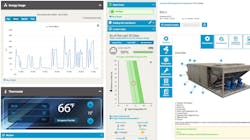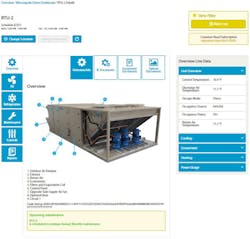Ensuring Peace of Mind, Remotely
Over the past several months, more building owners and facility managers have been forced to change the way they conduct their business to adhere to new, COVID-19-related guidelines and mandates. While sheltering-in-place and social-distancing requirements vary based on geography, there is a common need: facility staff must determine which controls and equipment require routine maintenance to support essential functions, and how to complete that work. Many owners also have had to navigate the financial pressure of reducing maintenance costs while their doors remain closed.
The impact at healthcare facilities and other buildings that house critical operations is acute and well understood. Maintaining indoor air quality and comfort is essential, and so is protecting front-line workers and patients from exposure. Also, when HVAC professionals are on site, safety procedures are paramount.
Other building types aren’t immune, however, even those that may be technically “closed.” Equipment and indoor environments still need to be maintained. For example, you can’t just shut down an HVAC system in a region where humidity and mold concerns are high. But access and, once again, safety pose challenges.
In both instances, remote monitoring is proving to be a viable and increasingly vital option — one that now is easier than ever to implement, thanks to technical advancements such as pre-configured controls, and cloud and wireless connectivity. The ever-decreasing cost of technology and cloud connection provides the ability to capture, store, evaluate and act upon data. Analytics algorithms turn massive amounts of bits and bytes into actionable insights based on how owners need to run their buildings. Users can also manage standardized, preset controls from a computer, tablet, or smartphone.
And it’s not just a solution for sizeable facilities and operations teams. With cost-effective setup and anywhere access, staff who manage small and medium-sized buildings can also share, track and transfer HVAC responsibilities, and ultimately save on the bottom line.
While traditional service and maintenance are still options in some areas, social distancing precautions and employee safety procedures are now top concerns. In contrast, remote monitoring allows maintenance staff and service providers to ensure equipment is running properly without being on site. If service is needed, owners and managers and contractors can view operational data, discuss options and decide on a course of action, all without leaving their computer or mobile device. Then the technician can arrive with a clear understanding of the issue and the appropriate parts to solve problems quickly and efficiently.
Through remote monitoring, facility personnel can limit exposure and ensure equipment functionality. This type of technology is used to monitor equipment diagnostics in real time and to receive notifications for potential issues. The system can combine data from the unit control panel and add cloud trending for continually improving predictive analytics capabilities. Once installed, users have complete, secure access to the data and can control who is able to view it.
Additionally, updating and fine-tuning equipment such as chillers and rooftop units, work that usually requires someone to be on the premises, also can be done from a distance via smart phones. When implemented properly, this technology reduces the number of service calls and therefore limits in-person interactions. Factory-recommended maintenance for each specific serial number can also be e-mailed to facility staff and tracked when completed, increasing uptime, reducing unplanned repairs and extending equipment life. Plus, using cell networks means IT departments do not need to be involved in establishing or maintaining connectivity.
In one South Florida school district, for example, remote monitoring technology from Daikin Applied is helping to maintain more than 35 buildings. Outside of the academic year, HVAC equipment still requires upkeep to ensure proper cooling and humidity levels.
On one recent weekend during the pandemic shutdown — with temps in the 90s and contractors not allowed on site — a chiller shutdown occurred. With monitoring equipment in place, experts were able to quickly receive and review a related alarm, analyze performance data, and determine the necessary repair. Collaborating with onsite staff, service was completed and recorded, and fellow facility managers in the district later received a comprehensive report outlining the issue and its solution.
This type of response gives operations personnel the peace of mind that buildings will continue normal functions even when they are away. In the case of an emergency, both outside and in-house specialists are able to respond in a timely manner, and assess and resolve issues. So remote monitoring technology is serving a critical need in this unprecedented time. But its utility will extend far beyond the ongoing pandemic, as HVAC continues to progress and evolve into a high-tech trade.
A graduate of Virginia Tech, the author is a mechanical engineer and product leader on intelligent solutions for better buildings.


